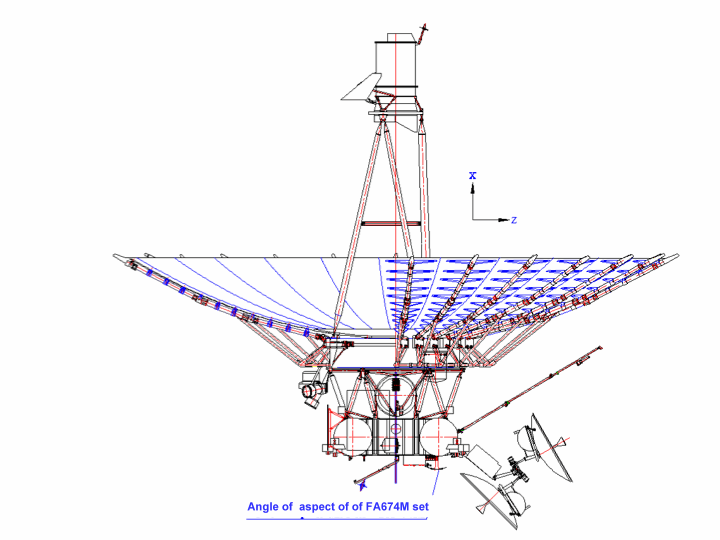
RadioAstron
Jump to: Mission Objectives, Mission Instrumentation, Mission Parameters, Additional Information
Mission Photos:

Courtesy of Lavochkin Association
Mission Objectives:
The RadioAstron project (the Spectr-R project) is an international collaborative mission to launch a free flying satellite carrying a 10-meter radio telescope in high apogee (~350,000 km) orbit around the Earth. The aim of the mission is to use the space telescope to conduct interferometer observations in conjunction with the global ground radio telescope network in order to obtain images, coordinates, motions and evolution of angular structure of different radio emitting objects in the Universe with the extraordinary high angular resolution.
The resolution achievable by RadioAstron would permit an investigation of the following targets of great interest of modern astrophysics:
- A study of the central engine of Active Galactic Nuclei (AGN) close to the events horizon of the supermassive black hole, via their structure and emitting nuclear regions dynamics, and, also, their spectra, polarization and variability.
- Parameters of the cosmological model, dark matter and dark energy in the Universe determined by means of the redshift dependence of the AGN parameters, and, also, by effects of gravitational lensing.
- Structure and dynamics of the star formation regions by the maser and megamaser spectral line emission.
- A structure of the star mass black holes, neutron and possible quark stars in our Galaxy (particularly, by the "interstellar interferometer" method), and determination of their proper motions and parallaxes.
- Structure and distribution of the interplanetary and interstellar matter by the investigation of fluctuations of the visibility function scintillation of pulsars.
- Construction of a high precision celestial coordinate frame.
- Development of a high precision model of the Earth gravitation field, and General Relativity tests by means of the precision redshift measurements.
SLR is very important for RadioAstron since the mission is devoted to study the following astrometric problems:
- Construction of a high-precision celestial coordinate frame
- Development of a high precision model of the Earth's gravitational field and testing the theory of General Relativity by means of the precision redshift measurements
Mission Instrumentation:
RadioAstron will have the following instrumentation onboard:
- Space radio telscope
Mission Parameters:
| Satellite: | RadioAstron |
| Sponsor: | Lavochkin Association, Russia |
| Expected Life: | 5 years |
| Primary Applications: | Interferometric applications |
| Primary SLR Applications: | precision orbit determination |
| COSPAR ID: | 1103701 |
| SIC Code: | 5559 |
| Satellite Catalog (NORAD) Number: | 37755 |
| Launch Date: | July 18, 2011 |
| NP Bin Size: | 60 seconds |
| RRA Diameter: | |
| RRA Shape: | Planar |
| Reflectors: | 100 corner cubes |
| Orbital Period: | 8.5-9.0 days |
| Inclination: | 51.4 degrees |
| Eccentricity: | 0.96 |
| Altitude: | 500-350,000 km |
| Weight: |
Additional Information:
Web sites:
- Astro Space Center home page
Publications:
- Bebenin, R., Ponomarev, Yu., Stepanyants, V., "Navigation of the RadioAstron Mission,", Fall 2009 ILRS Technical Workshop "SLR Tracking of GNSS Constellations", Metsovo Greece, September 14-19, 2009
- RadioAstron brochure
- RadioAstron Reflector Description




